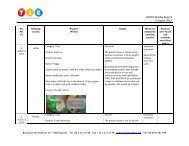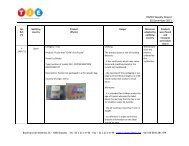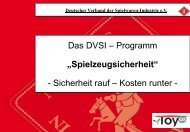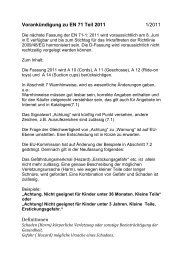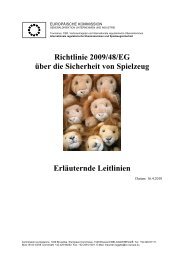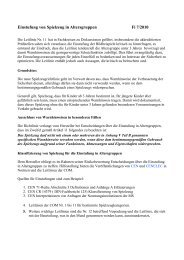You also want an ePaper? Increase the reach of your titles
YUMPU automatically turns print PDFs into web optimized ePapers that Google loves.
<strong>EN</strong> <strong>71</strong>-1:<strong>2005+</strong><strong>A8</strong>:2009 (E)<br />
The intention of the requirement for casing of toys in 5.1 g) is to ascertain the strength and durability of e.g.<br />
the casing of chiming toys, rattles, etc. which may include hazardous small parts, edges and points. If such<br />
casings crack, they will eventually fall apart and present hazards to the child.<br />
The purpose of the soaking test in 5.1 e) for toys that are glued together is mainly to check the strength of the<br />
joint. Other properties of the toy which might be affected by the soaking are not considered except thick<br />
surface coatings such as varnish which may come loose.<br />
Plastic stickers and decals (see 5.1 e)), self adhesive or not, glued on the toy and which come loose during<br />
the soaking test should pass the test for plastic sheeting as required in 4.3 (flexible plastic sheeting) and the<br />
small parts test (8.2).<br />
Wood knots in wooden toys are by nature never the same, and no conclusion about the safety level for a<br />
certain kind of products can be drawn from a single toy with loose wood knots. Small wood knots in wooden<br />
toys which can easily be pulled or pushed out are, however, to be considered as removable small components.<br />
A.27 Filling materials (see 5.2)<br />
These requirements are intended to address the hazards related to objects that can cause cuts or lacerations<br />
if accessible, or asphyxiation if inhaled, or harm by ingestion.<br />
Note that soft-filled toys and toys with coverings from which pieces can be bitten or torn off (e.g. foam toys)<br />
should meet the requirements in 8.3 (torque test) and 8.4 (tension test) as required in 5.1 (toys intended for<br />
children under 36 months, general requirements).<br />
A.28 Adhesion of plastic sheeting (see 5.3)<br />
These requirements are intended to address the hazards associated with plastic sheeting or plastic decals on<br />
toys - for example when children pull them off and put them over the face, forming an airtight seal capable of<br />
causing suffocation, or into the mouth.<br />
A.29 Cords on toys (see 5.4)<br />
These requirements are intended to address the hazards of strangulation associated with cords on toys that<br />
can form a noose around the neck of a child. They also address the hazards associated with self-retracting<br />
cords which might tangle with the fingers and other body parts, e.g. on a chiming toy.<br />
The requirement in 5.4 b) is to ensure that cords cannot be wound around the neck and constitute a<br />
strangulation hazard. The requirement in 5.4 c) is to prevent the child from pulling a noose over its head.<br />
A non-woven (monofilament) cord cannot easily form a noose. The requirement in 5.4 e) is intended to<br />
address the strangulation hazards associated with toys on a cord fixed across e.g. a cot. If the child tries to<br />
stand up in the cot, it might be entangled by the cord which could then form a loop around the neck, or the<br />
child might fall with the throat across it.<br />
Normal plastic tips on shoelaces are not considered as attachments likely to form a noose.<br />
A.30 Liquid-filled toys (see 5.5 and A.42)<br />
These requirements are intended to address the hazards associated with punctured teethers and similar<br />
products where the child might come into contact with liquids that are contaminated or become contaminated<br />
due to a puncture.<br />
The requirements do not apply to electrolyte in batteries nor to paints, finger paints or similar items in<br />
containers.<br />
84



